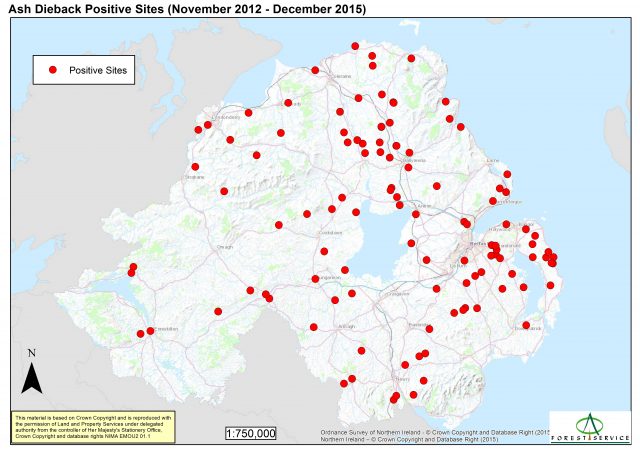The plant disease and invasive species threat posed to the environment in Northern Ireland is increasing, and likely to continue to do so due to factors such as increasing world trade and the potential impacts of climate change. These factors also increase the potential risk of the threats that we face diversifying and affecting a wider range of plant species.
Ash dieback impacts
Historically speaking, the issues of plant disease and invasive species have not been of great prominence for either the general public or policy makers within Northern Ireland. The recent high profile media coverage afforded to the Ash dieback disease (Hymenoscyphus fraxineus), in particular, has gone someway to changing this situation. Ash dieback disease causes leaf loss and crown dieback in ash trees and can also cause an infected tree to die. The disease was first discovered in Northern Ireland in the autumn of 2012 and was initially linked to trees that had been imported, and at that stage, was just found within recent plantings and nursery stocks.

As revealed in the figure, by 15th December 2015 ash trees infected with the disease had been identified at a total of 110 premises with recently planted ash, and three nursery/trade findings across Northern Ireland. Forest Service evidence provided to the Agriculture, Environment and Rural Affairs Committee on 8th September 2016 revealed that there had been ‘about 80 further outbreaks’ in 2016 and that the disease is ‘still spreading’. The previous DARD Minister, Michelle O’Neill, in responding to an Assembly question in October 2015, also confirmed that the disease had been identified in hedgerow ash at three locations in proximity to infected recently planted sites, which does raise the prospect that the disease could potentially be more widely dispersed.
The news of the disease being present within the wider environment is not encouraging given a recent article in the Journal of Ecology which suggested that the ash tree could well be eliminated in Europe. This gloomy assessment is based on an assessment of the evidence related to the impact of the disease on ash trees, combined with the impact of the emerald ash borer beetle. The ash borer beetle is an invasive species that is native to Asia and North America, the larvae of which kill ash trees through their feeding activity. Whilst the ash borer beetle is yet to be discovered in the UK, it is now thought to be present in continental Europe and will in all likelihood make it to the UK and Ireland.
Assessing the costs
The impacts of the potential loss of the ash tree to the environment in Northern Ireland are hard to accurately assess, but could be significant given that Northern Ireland’s current tree coverage level is 8% as compared to the UK figure of 13% and the EU average figure of 37%, plus the fact that the ash tree is the most common deciduous tree found here.
The threat to local ash trees posed by ash dieback disease and the emerald ash borer beetle is still developing, but this is only one example out of many threats that we face. Another topical and more established invasive species here is the Japanese Knotweed plant (Fallopia japonica) which presents a threat to buildings, hard surfaces and infrastructure, and which is estimated to cost the GB economy £179 million per year.
The way ahead
The growing threat from plant disease and invasive species presents future challenges for policy makers in Northern Ireland. Furthermore, any disease or invasive species which affected grass, such as the Argentine stem weevil (Listronotus bonariensis), could have a drastic impact on our pasture based agricultural systems. In this context, there may be a need to build upon documents such as the Invasive Alien Species Strategy and ensure that adequate resources are provided to meet the aims within it, as prevention may well be cheaper than cure.

